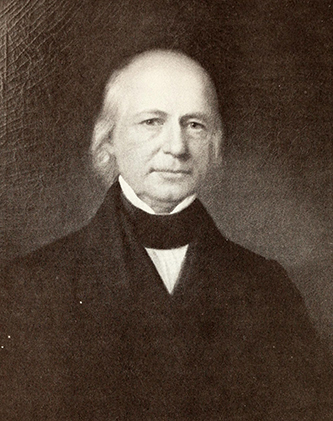Pettigrew, Ebenezer
10 Mar. 1783–8 July 1848
 Ebenezer Pettigrew, planter, U.S. congressman, and state senator, was born near Edenton of Irish and Scottish ancestry, the son of the Reverend Charles Pettigrew, planter and first bishop-elect of the Protestant Episcopal church in the Diocese of North Carolina, and Mary Blount, of Mulberry Hill, wealthy sister of the Revolutionary patriot Colonel James Blount. His mother having died in childbirth (1786), he was reared by his stepmother Mary Lockhart (m. 1794) and, after the death of his older brother John in 1799, by a somewhat grim and ultraconservative father. Following a brief stay in the preparatory division of the new University of North Carolina (1795–97) and further study at the Edenton Academy, he was withdrawn from school by his father in 1803 to assume responsibilities at the plantation in Washington County.
Ebenezer Pettigrew, planter, U.S. congressman, and state senator, was born near Edenton of Irish and Scottish ancestry, the son of the Reverend Charles Pettigrew, planter and first bishop-elect of the Protestant Episcopal church in the Diocese of North Carolina, and Mary Blount, of Mulberry Hill, wealthy sister of the Revolutionary patriot Colonel James Blount. His mother having died in childbirth (1786), he was reared by his stepmother Mary Lockhart (m. 1794) and, after the death of his older brother John in 1799, by a somewhat grim and ultraconservative father. Following a brief stay in the preparatory division of the new University of North Carolina (1795–97) and further study at the Edenton Academy, he was withdrawn from school by his father in 1803 to assume responsibilities at the plantation in Washington County.
Following his father's death in 1807, Pettigrew cared for his stepmother until her death in 1833 at Belgrade, the family plantation, and himself developed a second plantation and house, Bonarva, at Lake Phelps. His business flourished through fanatical hard work as he grew rice and wheat, cut lumber and shingles, and sold them in Baltimore, Philadelphia, New York, and occasionally Boston. While a bachelor he enjoyed traveling to visit his friends Thomas B. Haughton and James Iredell, Jr., at Princeton and his business associates in the larger cities; but following his marriage in 1815 to his cousin, Ann Blount Shepard of New Bern, he devoted his attention to his wife, his business, and his children. Always somewhat introverted and opposed to frivolity, he became even more so following the death of his wife in childbirth in 1830. The couple had nine children, of whom five lived to maturity: Charles Lockhart, William Shepard who entered the ministry, James Johnston who became a Confederate general and was killed in the Civil War, Mary Blount, and Ann Blount Shepard.
Pettigrew, always a conservative, was elected to the state senate for two terms (1809–10) and to the U.S. Congress (1835–37) as a Whig, defeating the Jacksonian incumbent Thomas H. Hall. His political career was undistinguished, his melancholy demeanor and taciturnity unfitting him for politics. As a planter he was more successful. In addition to Belgrade and Bonarva, he developed a third plantation, Magnolia, all in the same vicinity. The property he owned at the time of his death amounted to a substantial sum. It included lands, books, houses, cash, and the ninety people Pettigrew enslaved. In spite of his accumulated wealth, he lived simply and condemned the fashionable follies of the Josiah Collins family at adjoining Somerset plantation.
Pettigrew was buried in the family cemetery. The two vast collections of family papers reveal in minute detail the social mobility of four generations of Pettigrews. They concluded with the final collapse of their position after the Civil War emancipated enslaved laborers and destroyed the plantation system which profited from enslaved labor.
References:
Biog. Dir. Am. Cong. (1950).
John L. Cheney, Jr., North Carolina Government, 1585–1974 (1975).
Sarah McCulloh Lemmon, Parson Pettigrew of the Old Church (1970) and ed., The Pettigrew Papers, vols. 1–2 (1971, 1988 [portrait]).
Pettigrew Family Papers (North Carolina State Archives, Raleigh, and Southern Historical Collection, University of North Carolina, Chapel Hill).
Bennett H. Wall, "Ebenezer Pettigrew: An Economic Study of an Ante-Bellum Planter" (Ph.D. diss., University of North Carolina, 1946), "Medical Care of Ebenezer Pettigrew's Slaves" (access may be restricted to users with permission), Miss. Valley Hist. Review 37 (1950), and "The Founding of the Pettigrew Plantations," North Carolina Historical Review 27 (1950).
Additional Resources:
"Pettigrew, Ebenezer, (1783 - 1848)." Biographical Directory of the United States Congress. Washington, D.C.: The Congress. http://bioguide.congress.gov/scripts/biodisplay.pl?index=P000270 (accessed May 30, 2013).
Wall, Bennett H. “Ebenezer Pettigrew’s Efforts to Control the Marketing of his Crops.” Agricultural History 27 (October 1953): 123-32. http://www.jstor.org/stable/3740355 (accessed May 30, 2013, access may be restricted to users with permission).
John and Ebenezer Pettigrew to Charles Pettigrew, May 4, 1795. Documenting the American South, University of North Carolina at Chapel Hill. https://docsouth.unc.edu/true/mss01-01/mss01-01.html (accessed May 30, 2013).
Tarlton, William S; North Carolina. Division of State Parks. Somerset place and its restoration. [North Carolina : s.n.]. 1954. https://digital.ncdcr.gov/Documents/Detail/somerset-place-and-its-restoration/2691448 (accessed May 30, 2013).
Image Credits:
"Ebenezer Pettigrew (1783-1848), of Tyrrell County, was a planter, state senator, and United States congressman. Photograph of a portrait from the Southern Historical Collection, University of North Carolina Library, Chapel Hill."
The Pettigrew papers. Raleigh [N.C.] : State Dept. of Archives and History. 1971. Frontispiece. https://archive.org/stream/pettigrewpapers1988lemm#page/n5/mode/2up (accessed May 30, 2013).
1 January 1994 | Lemmon, Sarah McCulloh